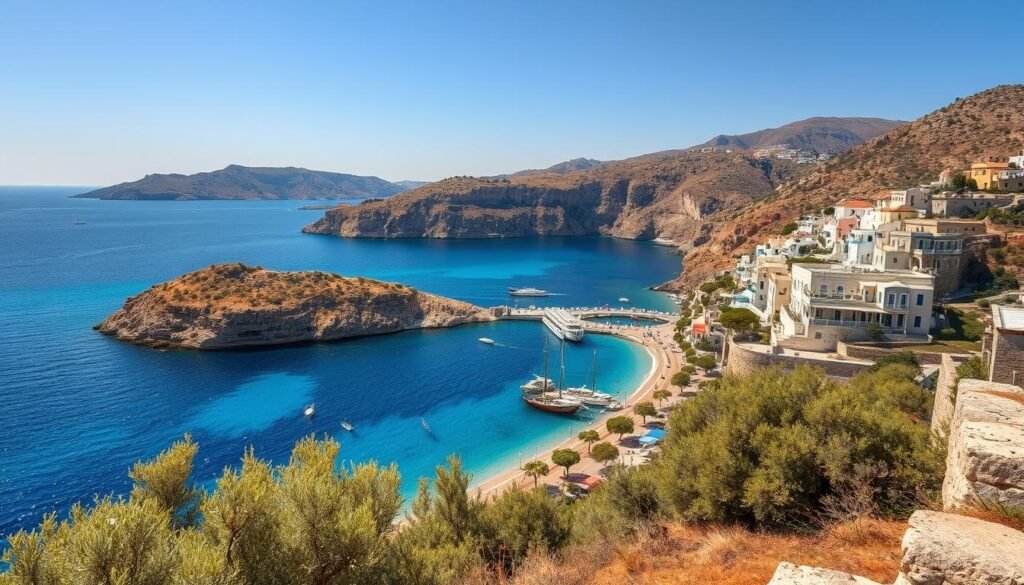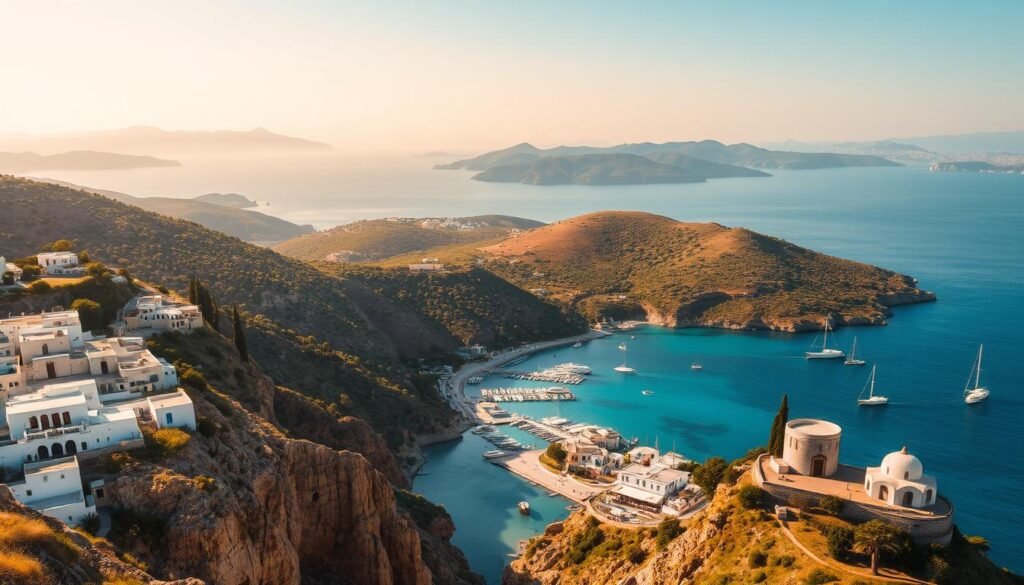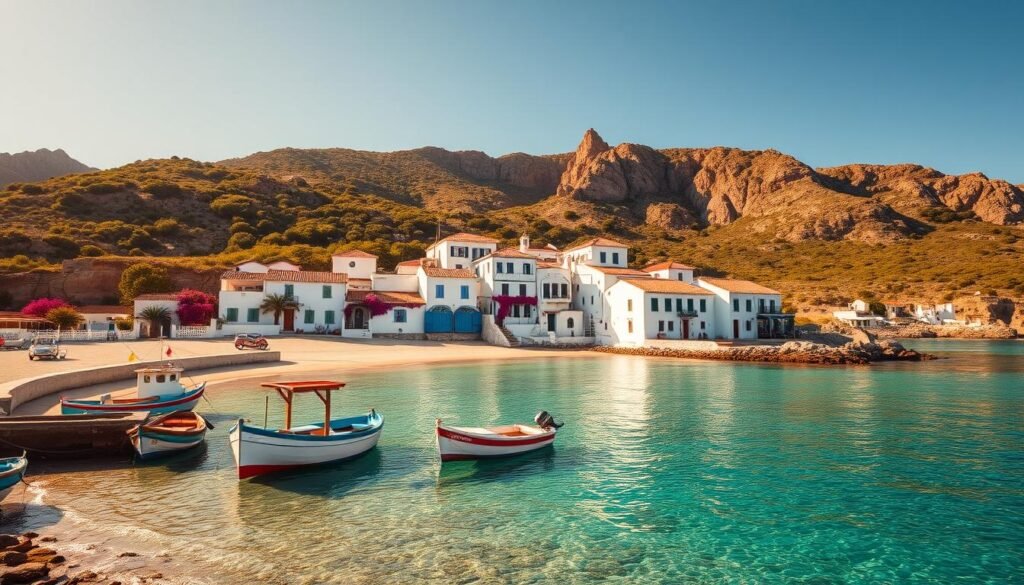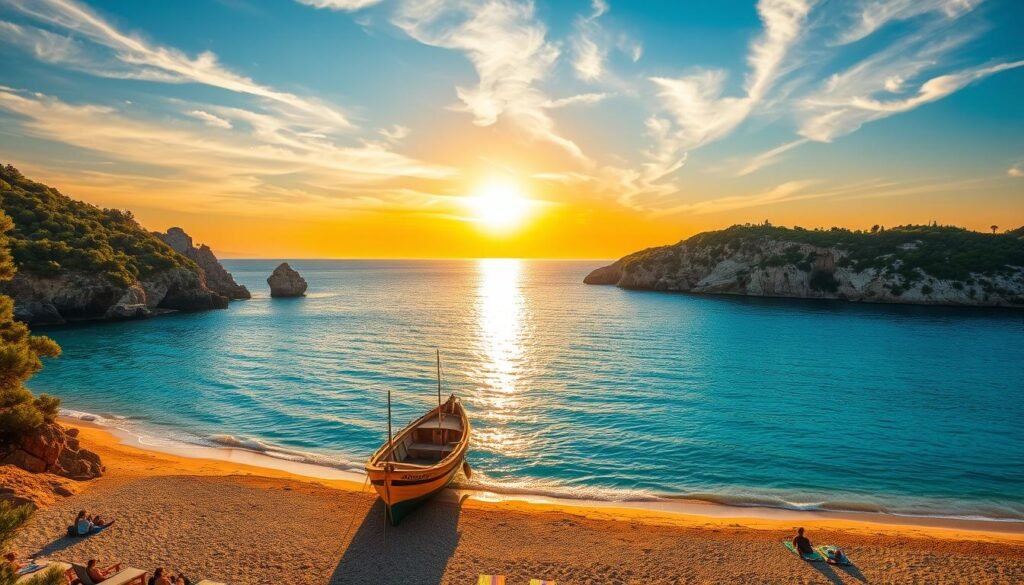Did you know that peak summer crowds can swell island populations by more than 300% on a single day? That scale changes how I plan a trip and what I choose to prioritize.
I focus on what I want most—beaches, culture, or deals—then match my travel window accordingly. For warm water and long beach days, late May through early October really stands out. The sea is warmest in July through September, but that also brings more travelers and higher prices.
To dodge crowds on islands like Mykonos and Santorini, I aim for late May–early June or September. Ferries run best from May through September, and low season (November–March) often cuts airfare by 30–50% and boosts hotel value in Athens and Thessaloniki.
Practical tip: I build a seven-day trip with 2–3 days in Athens, 3+ nights on one island, and a day trip to Delphi or Meteora.
For a deep dive on seasonal patterns and logistics, I check this guide from Travel + Leisure: best time to visit Greece.
Key Takeaways
- Match goals: pick your window for beaches, culture, or savings.
- Late spring and early fall balance weather, price, and lines.
- Warmest seas are July–September; islands are busiest then.
- Ferries run reliably May–September; meltemi winds may affect seas.
- Low season brings cheaper flights and hotel deals in cities.
How I decide the best season for a Greece trip based on weather, crowds, and budget
When I plan a Greek trip, I weigh weather, crowds, and budget like three equal dials I can turn. I start with the weather: warm, dry days for beach vacations or cooler, pleasant air for walking ancient sites guides my choice of season.
Crowds matter. Peak runs from early June through mid/late September, and popular islands and Athens get packed. If I want elbow room, I pick late spring or early fall to avoid long lines and crowded ferries.
I set a clear budget target and let it steer timing. Low season (November–March) often cuts international flights by 30–50% and brings strong hotel deals in Athens and Thessaloniki, though many island resorts close.
Operational realities also shape my plan: ferries are most frequent May–September, state-site fees drop Nov 1–Mar 30, and Greek Orthodox Easter can cause closures and higher rates outside Athens.
“I plan my days so two or three in Athens plus 3+ nights on one island beats nonstop hopping.”
- Match weather to activity (beach or sites).
- Choose shoulder months if you want fewer crowds and steady services.
- Book flights and hotels early for summer; expect prices to climb.
Best time to visit Greece: my quick-start take by travel style

I pick months based on what I want most: swimming and beaches, deep cultural walks, or big savings. That choice shapes where I go and how I book.
Beach and island-hopping
Late May–June and September are my go-tos for warm days, calmer towns, and frequent ferries. The water is comfortable for swimming, and islands feel relaxed without peak-season pressure.
Cultural sites and cooler exploring
I aim for March–April or October–November for walks and ruins. The weather is milder, lines are shorter at major sites, and I can spend more time on each stop.
Cheapest window
November–March (excluding holiday spikes) offers the lowest fares and big hotel discounts. I use the savings for food, guides, and longer stays in Athens or Crete.
Navigating peak season
Early June through mid/late September is the busiest and warmest stretch. If I must go then, I book flights and ferries six months ahead and plan early mornings or late afternoons to avoid heat and crowds.
- Tip: Pick one or two islands and build downtime into your days.
- Match destinations: Crete and Rhodes hold warmth longer; Delphi and Meteora shine in cooler months.
I use this quick framework so any traveler can visit greece with confidence and choose the best times visit without guesswork.
Greece by month: what I actually experience in winter, spring, summer, and fall
I map my year in Greece around how each month feels on the ground. Below I walk through the calendar so you know what I see day by day and where I head each season.
January–February
These winter months are city months for me. Athens and Thessaloniki stay lively with restaurants and nightlife, while many islands quiet or close.
Perk: state museums and sites are often half-price through March 30–31.
March
Spring shows up with blooms and Carnival energy before Orthodox Lent. Hours at some sites are shorter and bus links can be sparse, so I plan flexibly.
April
Weather turns mild and islands start reopening. I avoid Greek Easter weekend outside Athens because closures and prices spike.
May
Warm days arrive but seas stay cool. This month is ideal for quieter islands and sightseeing, though I watch May 1 strikes that can halt ferries.
June
Long sunny days and the first really refreshing swims. Crowds and prices climb; I book ferries and restaurant tables early.
July–August
Peak summer brings heat and meltemi winds. Islands are busiest; if I travel now I book six months ahead and build in afternoon siestas.
September
This is my favorite month for islands. Water stays warm, nights feel pleasant, and values improve as visitors thin out.
October
Shoulder-season comfort: mild weather, fewer lines, and still-good beach days in Crete and Athens. I pack a light rain layer for occasional showers.
November–December
I shift to serene city breaks and mountain escapes. Many small islands wind down by month’s end, while airfare and hotel deals show up.
“I use this monthly playbook to pick the right island-versus-mainland balance and time my days and nights for comfort and value.”
Islands vs. mainland: where I go each season

I decide whether an island escape or a mainland loop fits my mood and the season before I book anything. That choice shapes which places I prioritize and when I go.
Greek islands strategy
Icons like Mykonos and Santorini draw crowds and prices in peak summer, so I often book six months ahead for July–August. I pick quieter neighbors such as Paros in shoulder months to enjoy charm without stampedes.
Athens and Thessaloniki
I use the mainland for culture and food year-round. In fall and winter museums stay lively and hotel deals appear. Reduced site fees from Nov 1–Mar 30 make a city stretch feel even smarter.
Peloponnese, Delphi, and Meteora
For archaeology and vistas I aim for spring or October. Trails are cooler, buses are thinner, and licensed guides are easier to book.
Crete and Rhodes
These islands offer longer warm windows in spring and fall, great if I want beach days beyond core summer. I factor meltemi winds and choose mainland drives when seas are choppy.
- I blend city culture with one island for a balanced trip.
- I follow local rhythms so restaurants and experiences feel authentic even in busier months.
For an in-depth seasonal guide, I often check this concise resource: visit greece.
Planning essentials: flights, ferries, hotels, and weather realities

I build trips around a solid booking backbone: lock flights and hotels first, then shape island days and mainland stops. This keeps the schedule realistic and reduces stress when ferries shift or heat spikes.
Flights and hotels: when I book
Summer peak: I book flights for July–August at least six months ahead. That also helps secure better hotel rates in busy spots like Santorini and Mykonos.
Ferries and island-hopping
Ferries run most often May–September. I watch the meltemi wind (June–September) because it can delay sailings and make some crossings choppy.
Costs by season
International flights can be 30–50% cheaper in low season (Nov–Mar). Many island hotels close in winter, so I favor larger islands or the mainland then.
- Tip: Open-jaw flights (in one city, out another) save time and sometimes money.
- Tip: Pack for real weather: strong summer sun, a light rain layer in October, and warm layers for winter walks.
| Season | Booking window | Ferry reliability | Cost cue |
|---|---|---|---|
| Low (Nov–Mar) | Book 1–3 months | Limited; many routes reduced | Flights 30–50% cheaper |
| Shoulder (Apr–Jun, Sep–Oct) | Book 2–4 months | Frequent; good balance | Better value, fewer crowds |
| Peak (Early Jun–mid Sep) | Book 6+ months | Frequent but meltemi can affect crossings | Highest prices, full bookings |
“I avoid overstuffed itineraries—one or two islands plus a city cuts risk when ferries change.”
How many days you need and sample trips I recommend

I set a simple framework first, then layer in islands, museums, and meals around it. This helps me avoid rushed days and wasted flights.
Seven-night first-timer plan
For a seven-night trip, I aim for 2–3 days in the city of Athens for the Acropolis and the Acropolis Museum.
Then I spend 3+ nights on one island so transfers don’t eat the vacation. I add one mainland day trip to Delphi or Meteora for balance.
Shoulder-season foodie and wine escape
September is my pick for harvests and vineyard lunches. I seek vedema events on Santorini and grape harvests in the Peloponnese.
I center evenings around local restaurants and slow nights with music and tastings.
Winter city break
In winter, I base in Athens where museum and site fees drop from Nov 1–Mar 30. Hotels are friendlier and neighborhoods stay lively.
I recommend booking core flights early, then leaving room for a late morning and a long lunch so the trip feels relaxed.
- Rule: never book fewer than three nights on an island; transfers take time.
- Fly into Athens and out from an island (or vice versa) to save a day.
- Tailor the number of days to whether you want beaches, ruins, or food-focused slow travel.
“I prefer a slow morning, a long lunch, and one real night out—those choices make any trip feel like mine.”
Seasonal highlights to match your interests

My choice of month depends on what I want from the trip. Do I want long swims, quiet ruins, or an easy pace with locals? I use season as a simple filter so each day delivers the experience I expect.
Swimming and beaches
Seas are thoroughly warm by September, so I aim for that month when swimming matters most. June through September gives the most reliable beach days and the longest sunny afternoons.
Tip: pick beaches that shelter from the meltemi wind on breezier afternoons to keep your day calm and pleasant.
Ancient sites and cooler exploring
I schedule major sites in March, April, or October. The weather is cooler, the light is soft, and licensed guides are easier to book.
I linger longer at ruins in these months and avoid peak crowds so each site visit feels more personal.
Local life and lower crowds
Late fall through early spring is my window for Athens. Museum fees drop Nov 1–Mar 30, neighborhoods feel alive, and restaurant reservations are simple.
I treat July–August with caution for heat: early mornings and late afternoons are best, and midday is for shade, iced coffee, or a quiet taverna.
| Activity | Ideal months | Quick tip |
|---|---|---|
| Swimming & beach | June–September (peak sea warmth in Sept) | Choose sheltered shores from meltemi |
| Historic sites | March, April, October | Book a licensed guide; enjoy softer light |
| Local life | Late fall–early spring | Use savings from reduced fees for tours or tastings |
I often pair a morning swim with an afternoon site in shoulder months so I get both worlds without rushing. For a compact seasonal planning resource I check this seasonal guide before I finalize dates.
Conclusion
I choose trip windows by what I most want from each day—long swims, quiet ruins, or better hotel deals. That simple priority helps me pick the best time visit in any season and any year.
Peak runs early June through mid/late September, with the highest prices and busiest months. Late May–early June and September balance weather, crowds, and value, while November–March gives big savings on flights and hotels.
I plan my trips around realistic itineraries: one or two bases, buffers for ferries, and evenings reserved for restaurants and rooftop views. Pick months with intent, book the essentials early for peak, and leave room for surprises.
I’ll use this guide when I decide the right time year visit for me, so the country feels just right whenever I go. Those choices turn good trips into unforgettable ones.





















